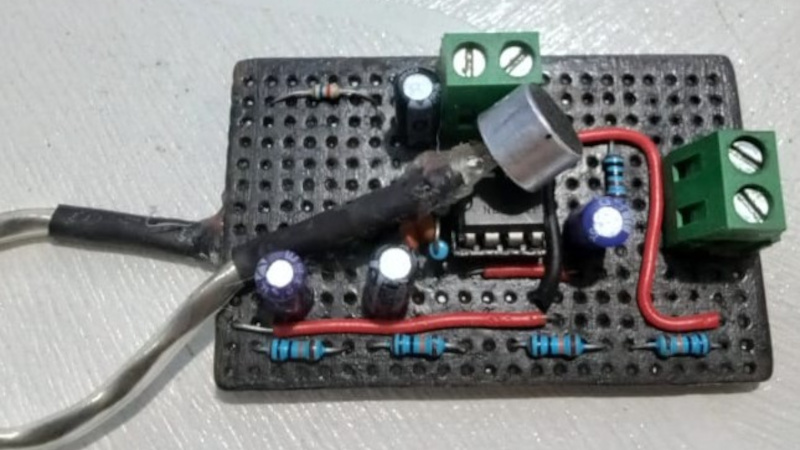Electret capsules can be found in some of the highest quality microphones for studio use, as well as in some of the very cheapest microphone capsules on the market. More care and attention has gone into the high-end capsule and its associated circuitry than the cheap one, but is it still possible to get good quality from something costing under a dollar? [Mubarak Basha] thinks so, and has designed a preamp circuit to get the best from a cheap electret capsule.
These capsules may be cheap, but with the addition of a low voltage supply, a resistor, and a capacitor, their internal FET delivers a decent enough input to many a project. To improve on that will need a bit of effort, and in this the preamp delivers by taking care to match impedance, impose a carefully chosen frequency response, and just the right gain to derive a line level output from the electret’s level. It’s hardly a complex circuit, but that’s not always necessary.
As always in these situations, without appropriate test equipment it’s difficult to gauge quality. We’d say this though, if you make one of these and it falls short, you won’t have spent much. Meanwhile if you’re curious about electrets, here’s our guide.
















Lodestone contributes to generating a clear-pitch voice in microphones by enhancing the performance of electret capsules. Electret capsules, which utilize a permanently charged material, are versatile and used in both high-end and inexpensive microphones. The high-quality capsules usually have more refined circuitry, leading to better audio quality. However, even affordable capsules can produce good sound through effective design. Incorporating lodestone can stabilize the diaphragm within the electret capsule, allowing for more accurate vibrations in response to sound waves. This stability helps ensure that the signals generated from voice input are clearer and more precise. Additionally, the design of specialized preamp circuits can further optimize the output from these inexpensive capsules, allowing the inherent benefits of lodestone to shine through, thus producing a clear-pitch voice in the microphone. This combination allows for quality sound reproduction even in lower-cost microphones.
AI generated nonsense
HaD needs to do something about AI slop comments.
It’s quite amusing that your comment not only surpasses the original article in length but also seems to be AI-generated, which feels a bit out of place in a section meant for genuine human input. Ironically, in a tongue-in-cheek twist, I’ve enlisted AI to craft this very response. Guess we’re both riding the same wave here!
I used ChatGPT on a Mac M4 to write this.
Someone using AI generated the idea to make a basic and not so great amplification stage. AI encouraged that this was good because why test things when you have a chat bot to tell you its good.
Someone then wrote an article using an LLM about it. Then someone AI generated a comment to boost engagement using AI. You then piled onto this nonsense using AI. I have now wasted 5 minutes of my life, and the world is closer to being less hospitable. Good show, lets ride this wave while there’s still water.
Yeah, I was trying to point out the absurdity of the whole thing.
I used My own human brain to compose and human fingers to type this.
That’s racist.
It looks like you are too preoccupied with bigotry to actually engage with the content, find something better to do.
If you didn’t want to actually write a post, don’t, or at least just post a link to Wikipedia, not generated garbage derived from corporate marketing
A basic non-inverting op amp stage is a hack now?
“Studio quality” but uses the worst performing biasing scheme.
It’s a hack because running a LM733 or NE5532 with a 5V supply is far off from manufacturer’s recommendations but still works somehow.
Hmmm. Seems worse than “Mitey Mic”published a decade or three ago in Audio Amateur.
I’d forgotten what it was called, but yeah.
VCC is 5V, the mic gets 4.5V and the input to the +ve of the op amp is 5V/2 so 2.5V. It looks to me that C1’s polarity is reversed.
You can make a perfectly functional electret mic preamp from 3/4 of a 74C04, three resistors, and two capacitors.
Replace the ¾ 74C04 with one BC549. Less noise and easier to source.